I’m thrilled to sit down with Simon Glairy, a leading expert in insurance technology and risk management, with a deep focus on AI-driven risk assessment. With years of experience in the Insurtech space, Simon has been at the forefront of innovating solutions to tackle the growing challenges of climate-related risks. In this interview, we explore how technology is reshaping insurance for extreme weather events, the unique advantages of parametric insurance, and the hurdles and opportunities in making coverage more accessible to those who need it most. We also dive into the role of data, personalized solutions, and partnerships in addressing the protection gap for property owners across the U.S.
How did your journey in insurance technology lead you to focus on climate risk management, and what excites you most about this space?
I’ve always been fascinated by how technology can solve complex problems, and my career in insurance naturally gravitated toward Insurtech as a way to modernize an industry that impacts so many lives. Climate risk became my focus because it’s one of the most pressing challenges we face today—extreme weather events are becoming more frequent and severe, leaving millions underinsured or uninsured. What excites me most is the potential to use tools like AI and data analytics to create faster, more transparent solutions that get help to people when they need it, like right after a flood or hurricane. It’s about turning a reactive industry into a proactive one.
What are some of the biggest gaps you see in insurance coverage for weather-related risks, and how are you working to address them?
One glaring gap is that a vast majority of Americans—around 95%—don’t have flood insurance, despite nearly every county in the U.S. experiencing severe flooding in recent years. The traditional model is often expensive, complex, and slow to pay out, which discourages people from getting covered. My work focuses on simplifying access through innovative products like micro parametric insurance, which offers affordable policies and rapid payouts. By leveraging technology, we’re trying to close this protection gap by making coverage intuitive and tailored to individual needs, ensuring people have a financial safety net after a disaster.
Can you explain what parametric insurance is and why it’s gaining traction as a solution for extreme weather events?
Parametric insurance is a game-changer because it’s based on predefined triggers, like a certain amount of rainfall or wind speed, rather than assessing damage after the fact. Unlike traditional insurance, where you file a claim and wait months for a payout, parametric policies use third-party data—think satellite imagery or weather station reports—to automatically activate payouts within days. It’s gaining traction because of its speed and transparency. People don’t have to prove loss; if the trigger is met, they get cash fast, which can be used for anything from property repairs to covering lost income. In a world where climate events are hitting harder and faster, this immediacy is critical.
How does the use of data and technology play a role in personalizing insurance solutions for weather risks?
Data is the backbone of personalization in this field. We pull from vast datasets, including historical weather patterns and real-time satellite information, to create unique triggers for each policyholder. For instance, someone in a flood-prone coastal area might have a rainfall trigger of nine inches in 48 hours, while someone inland might have a different threshold. Technology, especially AI, helps us analyze this data to understand not just where risks are, but how they impact specific communities. This lets us craft policies that are meaningful—responding to large-scale events that disrupt lives, not just minor inconveniences—and build trust through transparency since the data we use is publicly verifiable.
What challenges do you see in getting people to adopt parametric insurance, especially when many are unfamiliar with the concept?
The biggest challenge is education. Most people are used to traditional insurance and don’t understand how parametric works or why it’s beneficial. There’s also a general skepticism about insurance—folks think it’s too complicated or not worth the cost, especially for something like flood coverage that’s often separate from standard policies. We’re tackling this by focusing on accessibility and simplicity. By partnering with employers to offer these products during open enrollment, we’re meeting people where they already make insurance decisions. We also prioritize clear communication, breaking down the process so policyholders know exactly what triggers a payout and how quickly they’ll get funds.
How do partnerships, like those with employers, help in expanding access to climate risk coverage?
Partnering with employers is a strategic way to reach large groups at scale. During open enrollment, employees are already thinking about benefits like health or dental insurance, so it’s a natural moment to introduce climate coverage as equally essential. Employers also have a vested interest in their workforce’s resilience—disasters lead to financial shocks that affect productivity and retention. By integrating our products into these existing systems, we reduce friction for the end user and help employers support their teams’ recovery from events like floods or hurricanes. It’s a win-win that ties business continuity to individual financial security.
Looking ahead, what is your forecast for the evolution of insurance products in response to increasing climate risks?
I believe we’re on the cusp of a major shift toward more holistic and interconnected insurance solutions. As climate risks intensify, we’ll see products that cover multiple perils—like rainfall, heat, and wildfires—in a single marketplace, recognizing that communities often face back-to-back events. Technology will drive this by enabling faster risk assessment and payout mechanisms, while AI will refine predictive models to anticipate where needs will arise. I also expect parametric insurance to become mainstream, especially as carriers who’ve pulled out of high-risk areas use it to re-enter markets with controlled exposure. Ultimately, the focus will be on resilience—building products that don’t just react to disasters but help people and communities prepare for and recover from them more effectively.









